Environmental Print
You can use catalogs, magazines, store flyers, food boxes, clothes labels, photographs, etc. to capture children’s interest in print.
Photos from School and Community – Take pictures around your school and community and use them for a bulletin board or a book.
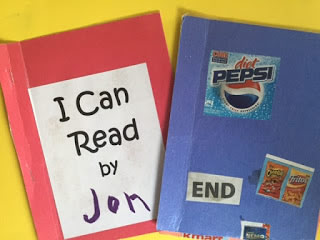
I Can Read! Make a blank book for each child where they can cut out and glue words that they can read. You could also let them “save” words they can read in a zip bag.
I Like! Ask children to cut out labels from food they like, such as cereal,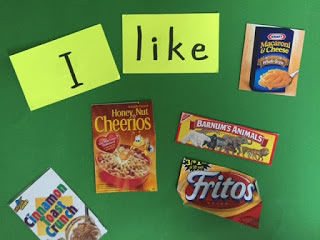
candy wrappers, snack foods, etc. Write “I” on one index card and “like” on another index card for each child. Children spread out the cards and add food labels as they make sentences that they can read. For example: “I like Gold Fish.” Attach magnetic tape to the back of the cards and logos for children to use at home on their refrigerators.
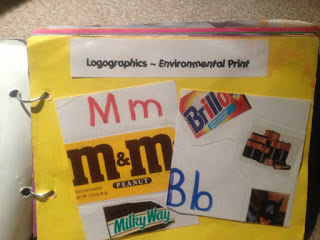 Eating the ABC’s – Take 26 sheets of paper and write a different letter on each page. Make a front and back cover for the book. Children bring in wrappers and glue them under the appropriate letter.
Eating the ABC’s – Take 26 sheets of paper and write a different letter on each page. Make a front and back cover for the book. Children bring in wrappers and glue them under the appropriate letter.
Hint! This is really fun to make with candy wrappers after Halloween.
Box Tops – Have children bring in empty food boxes from home. Cut the fronts and backs off the boxes. Mix them up, and then ask the children to match the fronts and the backs. You could also play a memory game with the box tops by placing them face down on the floor.
Coupons – Bring in the Sunday paper and let the children cut out the coupons. Children can sort the coupons or use them in the housekeeping area or math center.
Signs – Make traffic signs for the block center. Attach to toilet paper rolls so they will stand up. (You can find these at “google images.”)
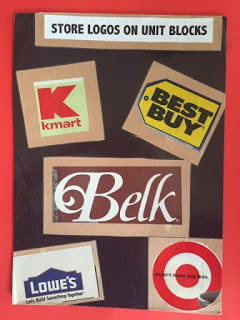
Store Signs – Cut store logos from the Sunday paper and tape them to blocks. Children can use these to build shopping centers.
Clothes – Read labels on clothes children wear to school, such as T-shirts, sports shoes, etc.
Seasonal Words – Display seasonal and holiday words with picture clues in the writing center.
Walk and Read – Walk around the school and make a list of words that you see.
Newspaper – Let children highlight words or cut out words they can read.
Snack Food Wrappers – Have children save wrappers from snack foods. Sort, graph, put prices on them and buy with play money. Look for new vocabulary words on the wrappers, write sense sentences (“It looks like, smells like, feels like, tastes …”), make books, etc.
Fast Food Song – Collect sacks or napkins from restaurants and use to sing the “Pizza Hut” song.
Old Mother Hubbard –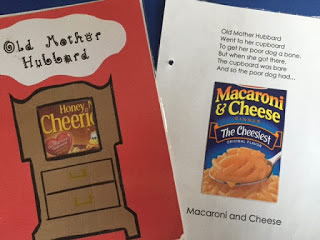 Write the verse below on each page and glue on the wrapper. Put together to make a book children will BEG to read!
Write the verse below on each page and glue on the wrapper. Put together to make a book children will BEG to read!
Old Mother Hubbard went to her cupboard
To get her poor dog a bone,
But when she got there, the cupboard was bare,
And so the poor dog had food wrapper.
Pictures, Letters, Words – Use environmental print to help children differentiate pictures, letters, and words. Fold a sheet of paper into a brochure (tri-fold). Let children cut out pictures, letters, and words from old magazines and newspapers. They can glue the pictures in the first section, letters in the second section, and words in the third section.
*Use highlighting tape or markers to find pictures, words, and letters on big books and posters.
Yummy Alphabet Letters
There are many ways to make chocolate chip cookies, and do you know what? They all turn out yummy! There are also many curriculums and different ways to teach alphabet letters. Here are some ideas to add to your program to make those letters taste yummy!
Tips to Remember!
*Kids just want to have fun! Focus on playful activities where children will be exposed to letters, sounds, words, and books in a variety of ways.
*The more senses you activate, the more likely the message will get to the brain! Children need to see, hear, smell, taste, and touch letters!
*The brain likes novelty and challenges! It’s got to be new and exciting to capture children’s attention.
*Repetition with feedback is important. Children must do things over and over again, but they must do it correctly with coaching.
*Prior-learning is important. If children know a little bit about something, then it’s easier to grasp the concept when formally presented. ABC books, rhymes, toys, and games are powerful ways to expose children to letters and sounds.
*The brain loves music and movement. Songs are the most “convenient” way to learn anything!
*Learning proceeds from simple to complex and from large to small. Build on children’s successes in small incremental steps.
*Everyone’s brain is unique and different. No two children learn in the same way or at the same time. Therefore, we must be sensitive to children’s individual styles, and we must provide them with a wide variety of opportunities to learn, play, and interact with letters and language.
Letter Office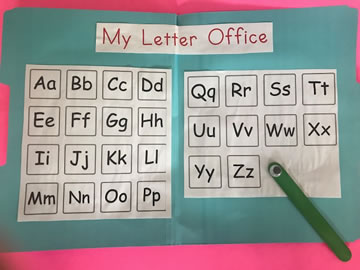
Tape two file folders together. Let children decorate the outside; then glue a copy of the alphabet letters on the inside.
Have children point to the letters as you sing various alphabet songs.
*Children can use their fingers and point to the letters in their “Letter Office” as you sing the “Alphabet Forward and Backwards,” “The Alphabet in My Mouth,” “Who Let the Letters Out?” and other letter songs.
*Use the offices for shared reading. Read the capital letters, lowercase, consonants, vowels. Read loud, soft, fast, slow, backwards, and other variations.
*Play “I Spy” and other games where children have to identify letters. Can they find the letter that makes the sound at the beginning of “hop”? Can they find the letters in their name? What comes between G and I? Can they match up magnetic letters with the letters in their offices?
Letter Wand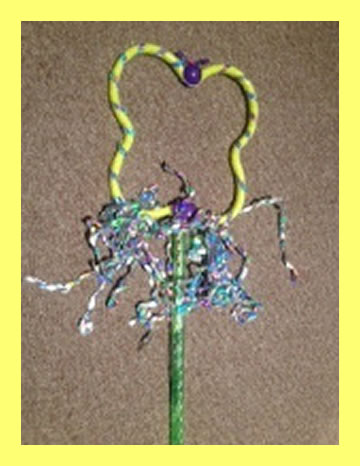
Remove the netting from a butterfly net. (You can find these at most dollar stores.) Add some colorful ribbons. Sing the song below to the tune of “Do You Know the Muffin Man?”
Do you see the letter name a letter,
The letter ____, the letter _____?
Do you see the letter name a letter,
Somewhere in the room?
A child takes the wand and frames that letter as she sings:
Yes, I see the letter _____,
The letter ____, the letter _____.
Yes, I see the letter _____
In the room.
Letter Beanbags
You can purchase beanbags with letters or you can make your own. Cut felt into 5” squares and sew three sides as shown. Fill with about ½ cup of beans and sew up the fourth side. Cut letters out of felt and glue to the beanbags.
Hint! Make one side of each beanbag out of red felt and the other side out of blue felt. Glue a lowercase letter cut out of red felt to the blue side, and an uppercase letter cut out of blue felt to the red side.
Toss and Catch – Pass out beanbags and let the children toss and catch them. Walk around the room and ask children to identify the letter on their beanbag.
Song Props – Use beanbags for singing different alphabet songs. Children
can toss their beanbags in the air, place them on the floor, or do other movements as their letter is sung on the song.
Making Words – Have children place their beanbags on the floor to make names or simple words.
Letter Badges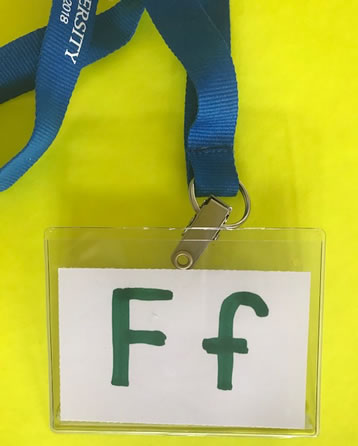
Purchase plastic name badge holders at an office supply store. (Or you can save these from conferences.) Choose one or two different letters each day and write them on paper cut to fit in the name badge. Select different children each day to wear the badges. Have children stand up as you sing the song below to the tune of “BINGO.”
There is a letter you should know,
What can the letter be oh?
/a/ /a/ It’s an A.
/a/ /a/ It’s an A.
/a/ /a/ It’s an A.
The letter A you know!
Let the badge wearer call on friends to say a word that starts with their sound.
*Challenge children to call friends by the letter they are wearing instead of their real name. For example: “D, come sit by me.”
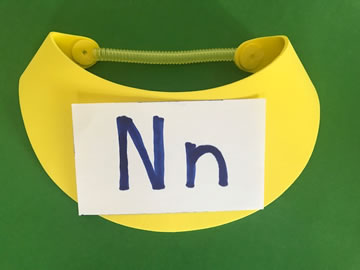
Letter Supervisor
You will need a plastic visor, index cards, and tape for this activity. Choose a different letter each day and write it on the index card. Tape the index card to the visor. Choose one child each day to wear the visor and be the “letter supervisor.” Every time you leave the classroom the letter supervisor stands at the door with her arm extended. Classmates must name the letter or say a word that starts with that sound before she raises her arm so they can exit the room.
Letter Bears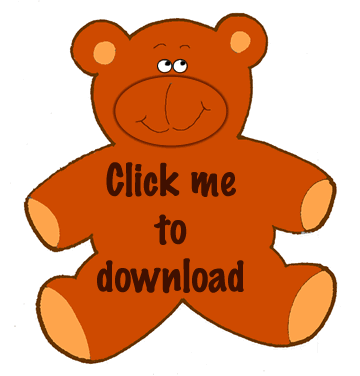
Cut 26 bears out of construction paper using the pattern you can download here.
Write a different letter on each bear. Sing the song to the tune of “Twinkle Little Star” as you hold up the bears.
(First letter) bear, letter bear, what do you see?
I see (second letter) bear looking at me.
(Second letter) bear, letter bear, what do you see?
I see (third letter) bear looking at me….
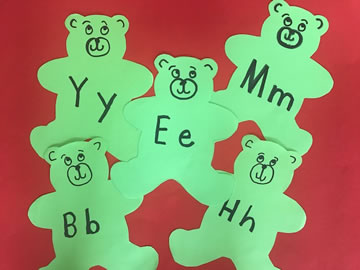
*Use the bears to dismiss children for centers or to line up by
having them look for the bear with the letter at the beginning of
their name.
*Use letter bears to assess children’s recognition of letters.
Rapper Necklaces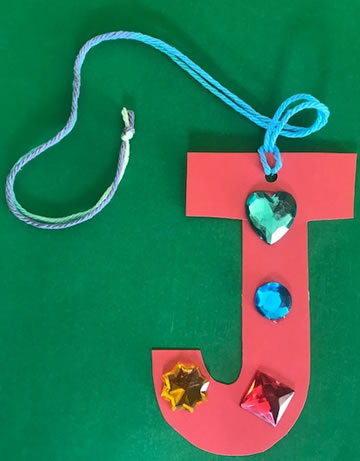
Cut out cardboard letters. Let children decorate them with fake jewels, glitter, or stickers. Punch holes in the letters and tie on string. Let children can wear these as you sing alphabet songs.
*Have the class stand in a circle. When the letter that their name starts with comes up in the song they ca n get in the middle of the circle and break dance.

 Eating the ABC’s – Take 26 sheets of paper and write a different letter on each page. Make a front and back cover for the book. Children bring in wrappers and glue them under the appropriate letter.
Eating the ABC’s – Take 26 sheets of paper and write a different letter on each page. Make a front and back cover for the book. Children bring in wrappers and glue them under the appropriate letter.

 Write the verse below on each page and glue on the wrapper. Put together to make a book children will BEG to read!
Write the verse below on each page and glue on the wrapper. Put together to make a book children will BEG to read!





